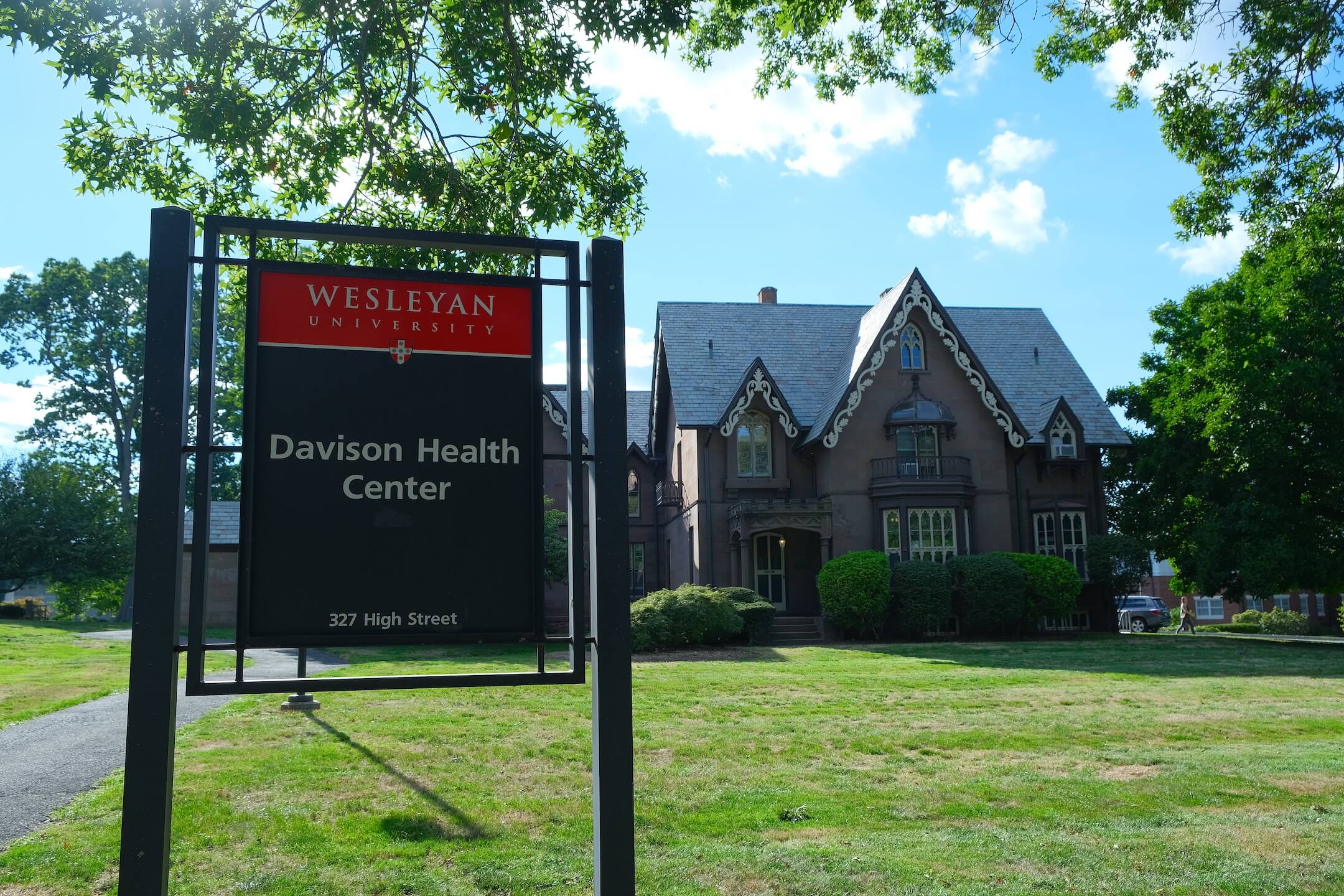
Outfitted in her KN95 mask with her EcoToGo container in hand, Zoe Hecht ’26 navigates through the crowds of Usdan during the height of the dinner rush. Hungry, but hoping to avoid other students as much as possible, Hecht quickly fills her box and hurries out of the hall, back to her COVID-19 isolation room on 159 High Street, which used to be Earth House. Hecht, then-positive for the coronavirus, is one of many students who contracted COVID-19 during the first few weeks of the semester—and one of many students who felt disappointed with the support she received from the University during her quarantine period.
During the first full week back on campus, from Jan. 30 to Feb. 5, there were 52 active COVID-19 cases on campus, according to the University’s COVID-19 dashboard. The following week, there were once again 52 active cases. Though this number has since dropped significantly, the first weeks of the semester saw extensive circulation of COVID-19 on campus, primarily among students.
With this surge of cases came a sudden need for COVID-19 isolation housing in order to reduce the spread of the coronavirus on campus, especially for students living in double or triple-occupancy dorm rooms. Though the University had robust isolation housing policies and practices during the height of the pandemic, this latest surge was met with what students report as a more disorganized and haphazard response from the University. While University leaders maintain that they have effective housing policies for students who test positive for COVID-19, the implementation of these policies has been, according to students, subpar.
Protective Plans
According to the University’s website, when students test positive for COVID-19, they must fill out a health update form and quarantine in their residential space for at least five days, and, if they continue to test positive, for up to 10 days. Administrators and Health Center staff must stay in contact with positive students to provide them with important resources while they navigate their quarantine period.
“When a student submits the form to report a positive covid test result, the Health Center processes it to enter the end date for their isolation and their first day to take another rapid test,” Associate Dean of Students Fran Koerting wrote in an email to The Argus. “They email the student helpful information as well as a note they can send to their professors.”
Isolation rooms are said to be available for students in circumstances that require them. Students can request one of these rooms via a form on the University’s website. Whether the student is placed in isolation housing or not, proper precautions are advised for all positive students and their close contacts.
“The student who tests positive as well as their close contacts should all wear masks when not in their bedroom,” Koerting said. “Isolation housing is available upon request for students in one room doubles, as they would remove their masks while sleeping.”
Based on the University’s website, it is assumed that students living in double or triple-occupancy rooms with students that test positive for COVID-19 will also test positive for the coronavirus and should therefore remain in their room with their positive roommates.
“For students who are in close contact with a COVID-positive roommate, it is likely they have already been exposed to the virus, therefore will not need to relocate to another room,” the policy states.
Coronavirus Catastrophes
While the University clearly has concrete policies in place to deal with COVID-19, according to many students, the execution of these policies has left much to be desired.
Hecht said she tested positive for the coronavirus the morning of the first day of classes. Though her roommate tested negative and exhibited no COVID-19 symptoms, when Hecht reached out to the University to inquire about isolation housing, she said the University was unable to give her a room. Though Koerting wrote that the re-housing of students due to facilities issues like floods did not interfere with the availability of isolation housing, Hecht said she was told by Koerting that she had to spend the night with her COVID-19-negative roommate because relocated Butterfields residents had occupied all of the isolation rooms.
Hecht also said she felt as though the communication she received was generally apathetic to her situation and towards occupants of multi-person dorm rooms.
“I was like, ‘Okay, so I have to spend a night in my room with my roommate who I don’t want to give COVID to before I may or may not have the chance to get a room,’” Hecht said. “There was literally nothing we could do. School policy is kind of like…‘Oh, you have COVID and you have a roommate? The roommate is getting COVID. Cut your losses, basically.’”
Hecht and her roommate spent their first night back on campus sleeping in masks. When Hecht was assigned to isolation housing the next day, she said she received minimal communication regarding its location, potential housemates, and protocol within her isolation room.
“I didn’t even know where they were going to put me,” Hecht said. “[The address] just was scrawled on the little envelope with the key. It was like a fun little treasure hunt to find where my COVID quarantine room was going to be.”
Hecht also said she received no assistance in moving all of her belongings from her room in West College to her isolation room.
“I spent like the next three or so hours of that day schlepping my stuff,” Hecht said. “I had to do three runs.… I was lucky that I was pretty much asymptomatic, but I was left wondering how someone with a medium to severe case of COVID could have possibly moved all of their stuff multiple blocks without help.”
After Hecht moved into her new isolation home on High Street, she was left to fend for herself. She said she was told to go to all-campus dining halls like Usdan or Summerfields and take food to-go to eat back at her housing location.
“Basically I had to go to Usdan with COVID and just load up on food in the little green containers,” Hecht said. “The whole time I couldn’t help but just feel like, ‘Whoa, I’m pretty asymptomatic. And so this is fine for me; it’s annoying, but I’m getting through it.’ But if somebody actually had COVID real bad, asking them to do everything I had to do would be a lot.”
To make matters worse, Hecht said that a few days into her quarantine, multiple COVID-19-negative students were relocated to the house she was living in to isolate from COVID-19-infected roommates who remained in their dorms.
“It just turned out that whoever requests the isolation room, they give the key to that person,” Hecht said. “It was better [than a dorm] in the sense that there were individual bathrooms for us to use and we had our own rooms and weren’t giving COVID to our roommates, but it was just weird. Like, why would they put the COVID people and the non-COVID people together?”
House residents said the co-habitation of the house by both infected and non-infected students caused anxiety for COVID-19 negative residents.
“The COVID [positive] people and the non-COVID people lived next to each other within the isolation house, which increased the chance of exposure,” Eugene Park ’26 said. Park was COVID-19-negative but placed with Hecht in the isolation house due to his roommate testing positive.
This melange of positive and negative cases within both dorms and isolation spaces led students to report feeling unsafe in regards to COVID-19 in their living spaces.
“I definitely did not feel safe in my dorm,” Isabella Lozada ’26 said. “My hall had both COVID-positive and negative students, like myself. There were no COVID bathrooms. It was just all mixed up. A lot of other people who were testing negative felt unsafe and felt like they had to use bathrooms on other floors to stay away from the people that had COVID and were still using those bathrooms because they had no other options. It was definitely a source of stress for a lot of people I talked to who did not contract COVID.”
Though many students have reported feeling unsafe on campus due to COVID-19 concerns and have advocated for amendments to the protocol for future case spikes, the protocol will not be changing in the near future, as cases have since dropped substantially, according to University President Michael Roth ’78.
“We revisit COVID protocols all the time and with cases going down we are not going to be making any changes in policy at this time,” Roth said.
Changing the Culture
Hecht was one of over 50 students who tested positive for COVID-19, and her story appears to be reflective of larger issues concerning the University’s implementation of COVID-19 quarantine housing policies. Upperclassmen living in houses have reported being denied isolation housing, leading some to resort to sleeping on friends’ floors or other makeshift isolation locations to avoid houses full of COVID-positive students.
Though cases are now significantly lower, many students impacted by the early-semester wave of infections have advocated for changes to COVID-19 protocol in the event of a future surge of cases. Instances like these have led students to report feeling as though the University does not care enough about their health.
“I definitely did not feel safe from COVID [on campus],” Lozada said. “The disjointed response to COVID cases [from the University] has sent the message to me and a lot of my friends that the University wants us to deal with COVID on our own, rather than for them to help us stay safe.”
Roth said he believes students can be responsible for their own COVID-19 safety.
“I think anyone who’s immunocompromised can take the appropriate precautions to protect themselves,” Roth said. “Students can work with their class deans or employees with their supervisors to make appropriate arrangements.… I think people [can] make the arrangements that suit them. I think that they don’t need the institution to make them do things, in this case.”
While these stories are indicative of struggles the University has had this semester with carrying out their COVID-19 housing protocols, Hecht said these shortcomings may also demonstrate that attitudes on campus towards illness as a whole need to change. Although COVID-19 cases may be low, the infrastructure previously used to address cases could be modified to improve safety on campus for illnesses beyond the coronavirus.
“What if, instead of getting rid of COVID isolation housing now that cases are so much lower, we held on to some of that infrastructure, and we got more rooms and we kept the Middletown Inn or whatever as a quarantine house, so that we could deal with other issues like the flu in a similar way so that it doesn’t spread through the student body like wildfire,” Hecht said. “That’s what happens when you’re living in such close quarters. We’re in doubles and triples and sharing communal spaces, which is the American college experience, but it’s also gross.”
If you have experienced something similar to the students mentioned in this article and would like to share your story, please reach out to Assistant Features Editor Akhil Joondeph.
Akhil Joondeph can be reached at ajoondeph@wesleyan.edu.



Leave a Reply